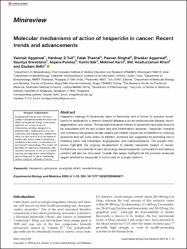Molecular mechanisms of action of hesperidin in cancer: Recent trends and advancements

Göster/
Tarih
2020Yazar
Aggarwal, VaishaliTuli, Hardeep S.
Thakral, Falak
Singhal, Paavan
Aggarwal, Diwakar
Srivastava, Saumya
Sethi, Gautam
Pandey, Anjana
Sak, Katrin
Varol, Mehmet
Khan, Md. Asaduzzaman
Üst veri
Tüm öğe kaydını gösterÖzet
Hesperidin belongs to flavanones class of flavonoids and is known to possess broad-spectrum applicability to prevent dreadful diseases such as cardiovascular disease, neurodegeneration, and cancer. The reported anticancer effects of hesperidin have been found to be associated with its anti-oxidant and anti-inflammatory activities. Hesperidin interacts with numerous recognized cellular targets and inhibits cancer cell proliferation by inducing apoptosis and cell cycle arrest. In addition, evidence has suggested its promising role in inhibiting tumor cell metastasis, angiogenesis, and chemoresistance. The present mini-review highlights the ongoing development to identify hesperidin targets in cancer. Furthermore, the potential of nano technology-based hesperidin combinations and delivery systems will also be discussed. Overall, this review highlights all the possible molecular targets affected by hesperidin in tumor cells on a single platform. Impact statement Experimental findings from numerous studies have demonstrated the anticancer effects of hesperidin (Hesp) to be associated with anti-oxidant and anti-inflammatory activities along with its potential role in inhibiting the tumor cell metastasis and angiogenesis. Additionally, Hesp can also reverse drug resistance of cancer cells, which make it a promising candidate to be used in combination with existing anti-cancer drugs. This review will be helpful for upcoming researchers and scientific community to find out complete capsular package about cancer drug targets of Hesp and its role in modulating various important hallmarks of cancer.

















